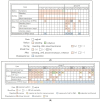Conservative Management for Retained Products of Conception in Late Pregnancy
- PMID: 36673536
- PMCID: PMC9859269
- DOI: 10.3390/healthcare11020168
Conservative Management for Retained Products of Conception in Late Pregnancy
Abstract
This retrospective study aims to compare the early manual removal of placenta (MROP) and conservative management of retained products of conception (RPOC) after 34 weeks of gestation. Nineteen cases underwent MROP within 24 h of delivery, of which nine patients had no symptoms requiring emergent treatment. These 9 patients (group M) were compared with 22 patients who were treated conservatively (group C). Massive bleeding was observed in 5 (56%) patients in group M and 11 (50%) patients in group C, with no significant difference in frequency. However, the lowest hemoglobin level within 72 h after massive bleeding was lower in group M (median: 6.7 vs. 7.7 g/dL, p = 0.029), suggesting that massive bleeding occurred in a short period of time. On the other hand, a retained placenta was observed in four patients in group M after the MROP; however, the placenta disappeared more quickly than in group C (median; 1.0 vs. 99.0 days, p = 0.009). In group C, all bleeding and infection occurred within 60 days of delivery, including heavy bleeding in six cases during the placental-extraction trial. Human chorionic gonadotropin in group C fell below the measurable threshold at a median of 67 days postpartum. In conclusion, for RPOC without urgent symptoms, early MROP and conservative treatment have their advantages and disadvantages. Randomized controlled trials are needed to determine which of those treatments is superior.
Keywords: human chorionic gonadotropin (hCG); postpartum hemorrhage; retained products of conception (RPOC).
Conflict of interest statement
The authors declare no conflict of interest.
Figures








References
-
- Weissbach T., Haikin-Herzberger E., Bacci-Hugger K., Shechter-Maor G., Fejgin M., Biron-Shental T. Immediate postpartum ultrasound evaluation for suspected retained placental tissue in patients undergoing manual removal of placenta. Eur. J. Obstet. Gynecol. Reprod. Biol. 2015;192:37–40. doi: 10.1016/j.ejogrb.2015.06.004. - DOI - PubMed
-
- Hoveyda F., MacKenzie I.Z. Secondary postpartum haemorrhage: Incidence, morbidity and current management. Bjog. 2001;108:927–930. - PubMed
-
- National Collaborating Centre for Women’s and Children’s Health (UK) Intrapartum Care: Care of Healthy Women and Their Babies During Childbirth. National Institute for Health and Care Excellence (UK); London, UK: 2014. - PubMed
Grants and funding
LinkOut - more resources
Full Text Sources

